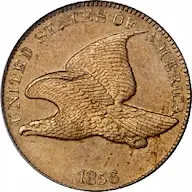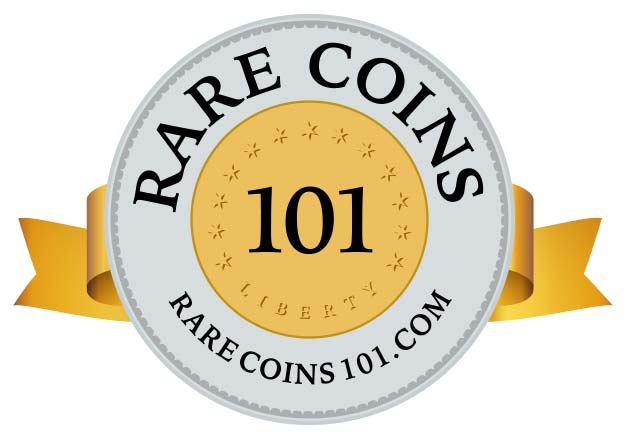1856 Flying Eagle Cent
By 1850, due to the rising price of copper, it was costing the Mint $1.06 to strike 100 of the clunky, disliked large cents, prompting consideration for smaller diameter patterns of various metal compositions.(1)
Finally, in 1856, Mint Director James R. Snowden settled on a light-colored alloy of 88% copper and 12% nickel for striking a one cent coin weighing less than half that of a large cent. For the design, Mint Engraver James B. Longacre placed an eagle in flight on the obverse and an ornate wreath reverse.
Without authorization, Snowden ordered hundreds of the 1856 Flying Eagle cents struck for presentation to members of Congress, where new coinage legislation was being debated. Other persons of influence also received samples.
In all, at least 634 of the new small cents were initially distributed, with a few more small batches going out to additional VIPs during the early weeks of 1857.(2)
The lobbying efforts paid off on February 21, 1857, when Congress approved production of the small cent. The 19 mm diameter of the Flying Eagle cent has carried forward to the familiar Lincoln penny.(3)
The Flying Eagle cent was a big hit with the American public. Demand for the new coin was high, particularly for examples dated 1856. Starting in late 1857 and continuing to 1860, restrikes of the 1856 were sold to collectors intrigued by the extraordinary coin.(4)
The 1856 Flying Eagle cent was made in both proof and business strike (i.e., non-proof) formats. It is commonly believed the 634+ examples that reached the halls of Congress in 1856 and early 1857 were business strikes. As for proofs, scholars estimate 1000-1500 were made, mostly as the later restrikes.(5)(6)
Technically, the 1856 small cent is a pattern coin (i.e., an experimental piece), since the law establishing the new coin wasn’t enacted until the following year. Unlike a typical pattern coin, it was struck in relatively large numbers, many of which reached general circulation.(7)
There are nine known pairings of obverse and reverse dies, called die varieties, (a.k.a. die marriages) used to strike the 1856 Flying Eagle cents. According to researcher Richard Snow, only two of them, the S-3 and S-5 varieties, were struck from dies fabricated in 1856 to strike most, if not all, of the pieces distributed to Washington dignitaries.(8)
As a result, the best-informed numismatists prize these varieties above all others, for they are viewed as originals and not restrikes.
The immediate popularity of the 1856 Flying Eagle cent upon its release ignited the first real coin collecting boom in the U.S., advancing the field of numismatics as never before.(9) The desire to claim ownership of this historic coin has remained strong ever since.
| Estimated survivors in all grades: 550 ?
The survivor estimate from PCGS represents an average of one or more experts' opinions as to how many examples survive of a particular coin in all grades. Survival estimates include coins that are raw, certified by PCGS, and certified by other grading services. Learn more at PCGS. |
| PCGS Rarity Scale: 5.9 ?
The 'PCGS CoinFacts Rarity Scale' assesses the relative rarity of all U.S. coins, based on estimated surviving examples. The scale runs from 1.0 to 10.0. The higher the number, the rarer the coin.
Learn more at PCGS. |
| Search for the 1856 Flying Eagle Cent on eBay** |
Preview of eBay selection (only the S-3 and S-5 die varieties are searched for):
 |
 |
| Trendline Avg = 8.94 | CLASSIC RARITY |
 |
 |
| Trendline Avg = 8.94 | CLASSIC RARITY |
Historic Value Trend Charts:
| Last updated 11-9-25 | Return to Key Date Coin List | |
| Compare to Common Date Coin of Same Type | ||
|
|
||
| Download Charts to Your Computer | ||
Sources
1. PCGS. Flying Eagle Cent.
2. PCGS. 1856 1C Flying Eagle (Regular Strike).
3. Garrett, Jeff and Guth, Ron. 100 Greatest U.S. Coins, 5th ed. Pelham, AL: Whitman Publishing, 2019.
4. Stack's Bowers Galleries. 1856 Flying Eagle Cent. S-9. Proof-65+. Mar 2018 Auction.
5. Heritage Auctions. 1856 1C MS66 Snow-3. Jan 2004 Auction.
6. Stack's Bowers Galleries. 1856 Flying Eagle Cent. S-9. Proof-65+. Mar 2018 Auction.
7. PCGS. 1856 1C Flying Eagle (Regular Strike).
8. Heritage Auctions. 1856 1C S-3 MS65. Jan 2016 Auction.
9. Stack's Bowers Galleries. 1856 Flying Eagle Cent. S-9. Proof-65+. Mar 2018 Auction.
**Many very fine coin dealers sell on eBay. At any point in time, there may be over one million search results for United States coins. This includes quite a few of the recommendations on our Key Date Coin List.
If you’re thinking about purchasing a rare coin, eBay is certainly worth a look. For your convenience, the links from this site to eBay are coded to bring up only coins certified by PCGS and NGC.
As is always, always the case, never buy a valuable coin from a seller whose trustworthiness cannot be verified. Learn more about this at our chapter Best Places to Buy Coins, which also has a section on doing business on eBay.
In the interest of full disclosure, Rare Coins 101 receives a small commission anytime someone connects to eBay from this site and purchases something.
Coin Images by Stack's Bowers Galleries.


